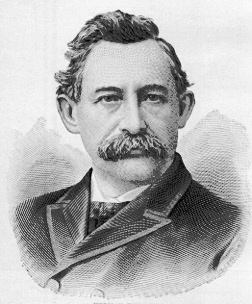|
OMAHA
ILLUSTRATED.
and threw him under the table. A general
free fight ensued, in which the Omaha men gained a complete
victory. The next morning each house passed a resolution
adjourning to Florence. Their action, however, was not
recognized by the Governor, Hon. W. A. Richardson, of
Quincy, Illinois, who succeeded Governor Izard and arrived
here shortly after the adjournment to Florence. This session
of the Legislature was held in the territorial capitol
building which had been erected on Capitol Hill. The
contract was made November 29, 1855, and the building was to
have been completed in September 1856. It was not finished,
however, until
|
[The
name of Kountze Brothers, bankers, in Omaha, Denver
and New York, is well known throughout the country.
There are four brothers living -- Augustus, Herman,
Luther and Charles B. They are the sons of
Christian Kountze who, when a young man, emigrated
from Saxony, a German province in Europe, to the
United States. Two years after his arrival in this
country he married Margaret Zerbe, a native of
Pennsylvania, and located in Osnaburg, a small
village in Stark county, Ohio, where he engaged
|
|
in mercantile pursuits, and continued in
business at the same place until his death, a
period of about forty years. Christian and Margaret
Kountze raised a family of ten children --- five
sons and five daughters. Augustus Kountze was born
Nov. 19, 1826, and Herman Kountze was born Aug. 21,
1833. All the sons acquired their business training
under their father's care. Augustus entered his
father's business house at the age of fifteen and
continued until 1854, and was the first to leave
the old home, going from there to Muscatine, Iowa,
the then far West, where he engaged in the real
estate business. In the summer of 1855 Omaha was
first brought to his notice as a probable coming
city, and he came here and made a few investments.
Early in the spring of 1856 he returned and made it
his home until February, 1872. Herman Kountze
commenced business in his father's store at the age
of
|

HERMAN KOUNTZE.
|
ten years and remained there until the fall of
1856, when he left home and came direct to Omaha.
The younger brothers followed from time to time
until all the sons had taken up their homes either
in Nebraska or Colorado. William, the fifth
brother, came to Nebraska in 1959 and died the same
year at Dakota City. Augustus and Herman, having
grown up together, have from boyhood had many
interests in common. They have continued the
business of buying and selling real estate from the
time of coming West until the present. In the early
days of Nebraska they bought considerable property
in the river towns of the State. They had holdings
in Brownville, Nebraska City, Tekamah, and Dakota
City, Nebraska, and also in Sioux City, Iowa. None
of the Missouri river ventures, however, proved
profitable except those in Omaha. They also had
large holdings in Iowa and
|
|
Minnesota lands, and later on invested heavily
in Nebraska lands. At a still later period they
bought considerable real estate in other places,
principally in Chicago and Denver, and also
invested in Texas pine and grazing lands. In the
fall of 1857, after the great financial panic, real
estate became very unsalable, and some of the local
banks at Omaha having failed, Augustus and Herman
Kountze commenced the banking business under the
firm name of Kountze Brothers, and continued as
such until 1864. Meantime they organized the First
National Bank of Omaha, which was the first bank
organized in Nebraska under the National Banking
Law. At the time of its organization the late Mr.
Edward Creighton was made president of the bank, in
which capacity he continued until his death. Herman
Kountze was appointed cashier and filled that
position for several years; later on he became
vice-president and Augustus Kountze was made
cashier. Upon the death of Mr. Creighton, Herman
Kountze was elected president of the bank and has
since remained in that position. In the fall of
1862, Luther Kountze, a younger brother, went to
Denver and was soon followed by Charles B. Kountze,
who was the last of the boys to leave the old home.
Upon arriving in Denver Luther opened a bank under
the name of Kountze Brothers, the senior members
being Augustus and Herman. In 1866 they organized
the Colorado National Bank, of Denver. They have
ever since remained in the control and management
of that institution, and are prominently connected
with other business interests of that city,
particularly in the Holden Smelting and Reduction
Works, in which they have invested largely. During
1867 Luther Kountze went to New York, and in 1868
opened a banking house in that city under the firm
name of Kountze Brothers, of which Augustus and
Herman Kountze are the senior members. In 1872 the
New York business had grown to such an extent that
it became necessary for another member of the firm
to be in that city and, accordingly, Augustus
Kountze left Omaha and took up his permanent
residence in New York, assuming, in connection with
Luther, the management of the business in that
city, which is still continued under the old firm
name and includes the four brothers. Augustus
Kountze was married June 14, 1859, to Miss
Catharine Ruth, of Hanoverton, Ohio. Herman Kountze
was married May 10, 1864, to Miss Elizabeth Davis,
the daughter of Mr. Thomas Davis, one of the
pioneers of Omaha and Nebraska, but now a resident
of Indianapolis. Augustus and
[28]
|
|